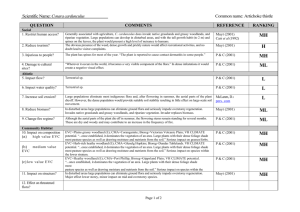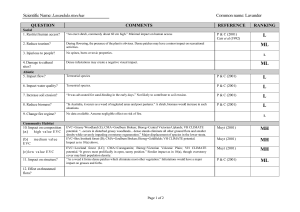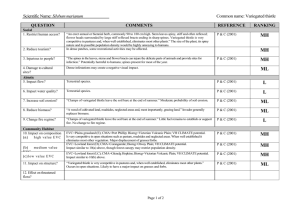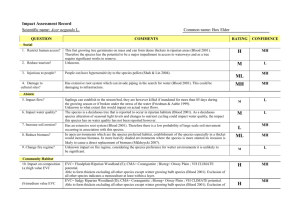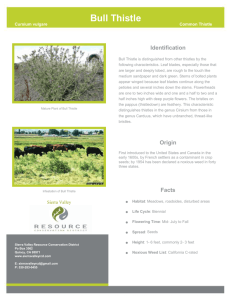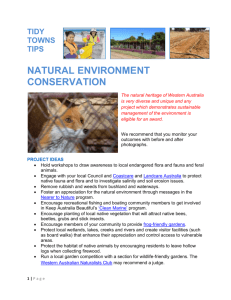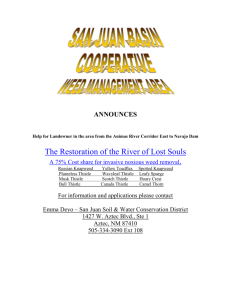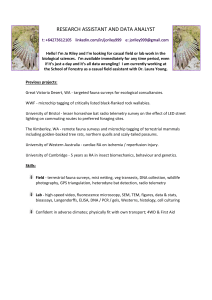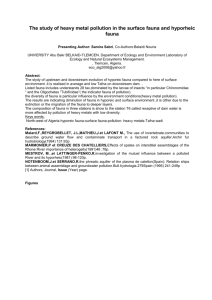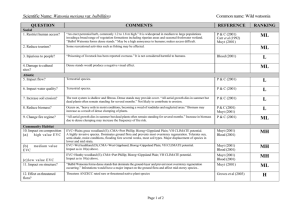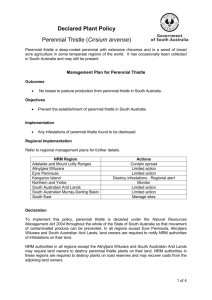Impact Assessment Record - Slender thistle (DOC - 60KB)
advertisement
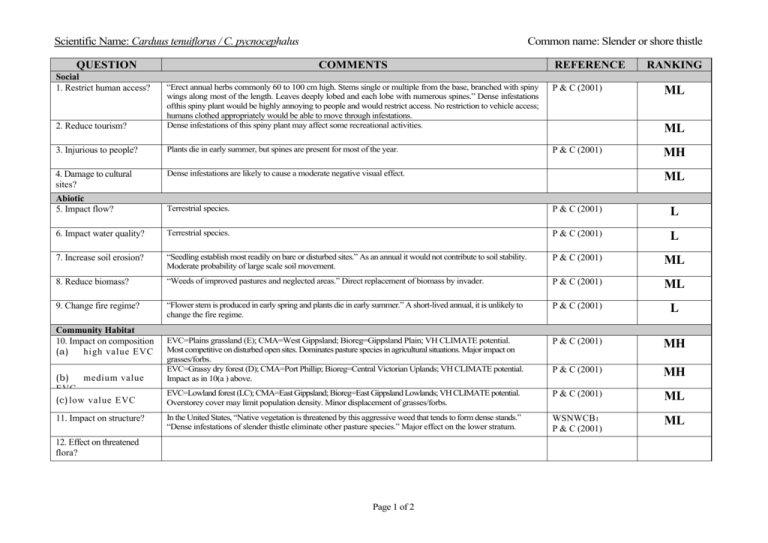
Scientific Name: Carduus tenuiflorus / C. pycnocephalus QUESTION Social 1. Restrict human access? Common name: Slender or shore thistle COMMENTS REFERENCE P & C (2001) 2. Reduce tourism? “Erect annual herbs commonly 60 to 100 cm high. Stems single or multiple from the base, branched with spiny wings along most of the length. Leaves deeply lobed and each lobe with numerous spines.” Dense infestations ofthis spiny plant would be highly annoying to people and would restrict access. No restriction to vehicle access; humans clothed appropriately would be able to move through infestations. Dense infestations of this spiny plant may affect some recreational activities. 3. Injurious to people? Plants die in early summer, but spines are present for most of the year. P & C (2001) 4. Damage to cultural sites? Dense infestations are likely to cause a moderate negative visual effect. RANKING ML ML MH ML Abiotic 5. Impact flow? Terrestrial species. P & C (2001) L 6. Impact water quality? Terrestrial species. P & C (2001) L 7. Increase soil erosion? “Seedling establish most readily on bare or disturbed sites.” As an annual it would not contribute to soil stability. Moderate probability of large scale soil movement. P & C (2001) ML 8. Reduce biomass? “Weeds of improved pastures and neglected areas.” Direct replacement of biomass by invader. P & C (2001) ML 9. Change fire regime? “Flower stem is produced in early spring and plants die in early summer.” A short-lived annual, it is unlikely to change the fire regime. P & C (2001) L EVC=Plains grassland (E); CMA=West Gippsland; Bioreg=Gippsland Plain; VH CLIMATE potential. Most competitive on disturbed open sites. Dominates pasture species in agricultural situations. Major impact on grasses/forbs. EVC=Grassy dry forest (D); CMA=Port Phillip; Bioreg=Central Victorian Uplands; VH CLIMATE potential. Impact as in 10(a ) above. P & C (2001) MH P & C (2001) MH EVC=Lowland forest (LC); CMA=East Gippsland; Bioreg=East Gippsland Lowlands; VH CLIMATE potential. Overstorey cover may limit population density. Minor displacement of grasses/forbs. P & C (2001) ML In the United States, “Native vegetation is threatened by this aggressive weed that tends to form dense stands.” “Dense infestations of slender thistle eliminate other pasture species.” Major effect on the lower stratum. WSNWCB1 P & C (2001) ML Community Habitat 10. Impact on composition (a) high value EVC (b) medium value EVC (c) low value EVC 11. Impact on structure? 12. Effect on threatened flora? Page 1 of 2 Scientific Name: Carduus tenuiflorus / C. pycnocephalus QUESTION Fauna 13. Effect on threatened fauna? 14. Effect on nonthreatened fauna? Common name: Slender or shore thistle COMMENTS In the United States, “Native vegetation is threatened by this aggressive weed that tends to form dense stands.” In Victoria, the species are widespread in medium to large populations. The plants are not readily grazed by stock, therefore infestations may have a serious impact on the habitat of fauna species. 15. Benefits fauna? No known benefits to fauna species. 16. Injurious to fauna? “Slender thistle is not readily grazed by stock because of its spiny nature.” Spines may cause some injury to fauna, though this is not documented. REFERENCE WSNWCB Carr et al (1992) P & C (2001) P & C (2001) MH P & C (2001) ML minor pest species. Agriculture 19. Impact yield? 20. Impact quality? MH H Pest Animal 17. Food source to pests? “Several birds, notably goldfinches [Carduelis carduelis European goldfinch] eat the seeds.” Food source to 18. Provides harbor? RANKING Not documented to provide harbor. A short-lived annual. L “Slender thistle is not readily grazed by stock because of its spiny nature, and its presence also discourages animals from grazing neighbouring pasture plants. Dense infestations of slender thistle eliminate other pasture species.” Likely to reduce carrying capacity and thus have a major impact on quantity. Not known as a weed of cropping in Victoria, however, “in Tasmania it is also an important competitor with annual crops.” Not known as a weed of cropping in Victoria, or to affect the quality of produce or harvest. 21. Affect land value? Impact on agricultural yields may reduce land value, but Carduus pycnocephalus and C. tenuiflorus, like Cirsium vulgare, are widespread throughout southern Australia, and C. vulgare is, “accepted as a permanent part of the vegetation. “...if stock is excluded from weed patches through autumn and winter, the rosette leaves become erect with 22. Change land use? softened spines, and stock eat these plants in late winter and spring, often in preference to other species.” Using this deferred method of grazing may improve land availability. 23. Increase harvest costs? Not known to affect harvest costs. 24. Disease host/vector? None evident. P & C (2001) MH L P & C (2001) L P & C (2001) ML L L Washington State Noxious Weed Control Board. n.d. Italian thistle (Carduus pycnocephalus L.). Available: http://www.nwcb.wa.gov/weed info/italianthistle.html Date accessed 29/04/03 1 Page 2 of 2
